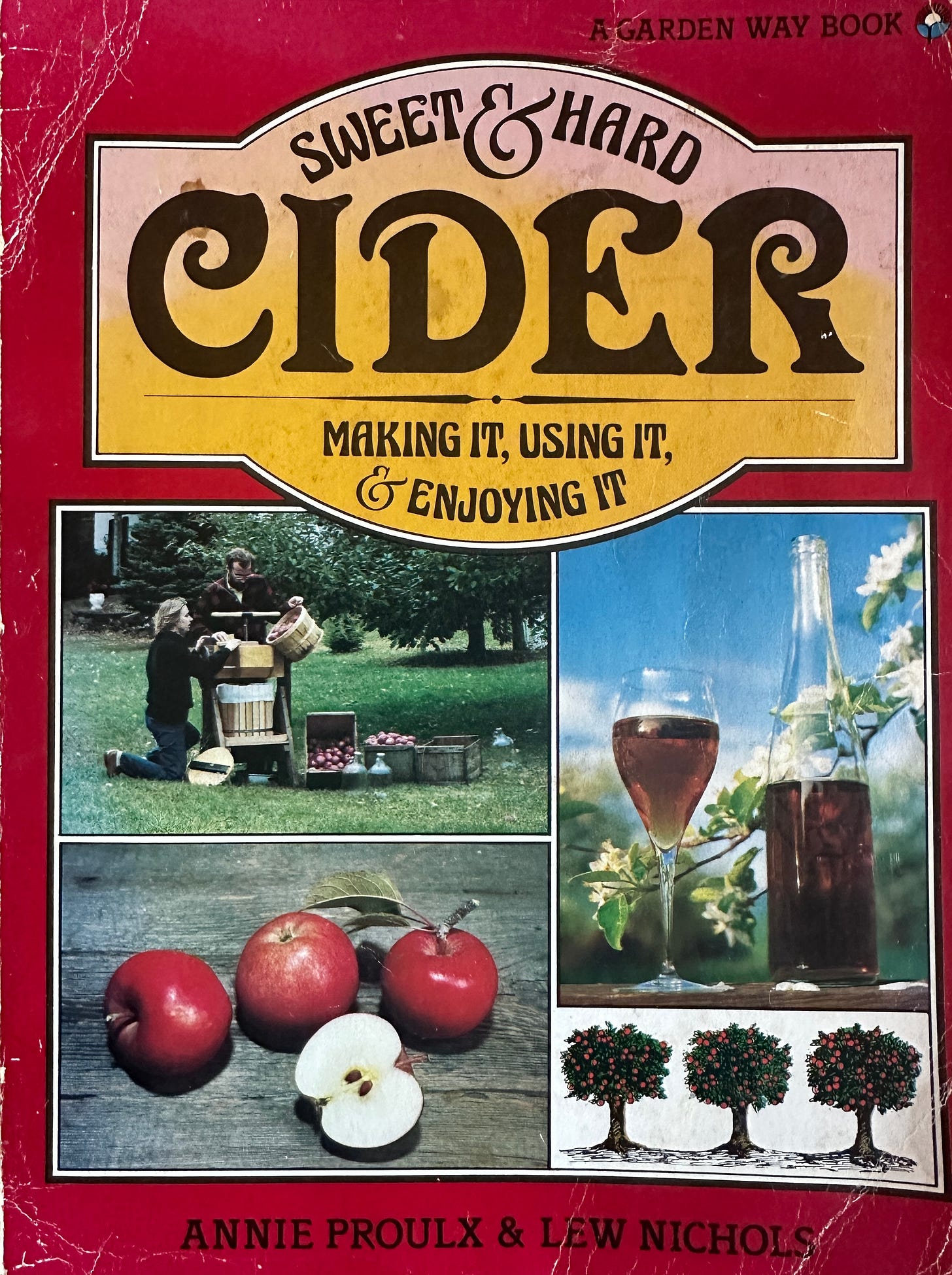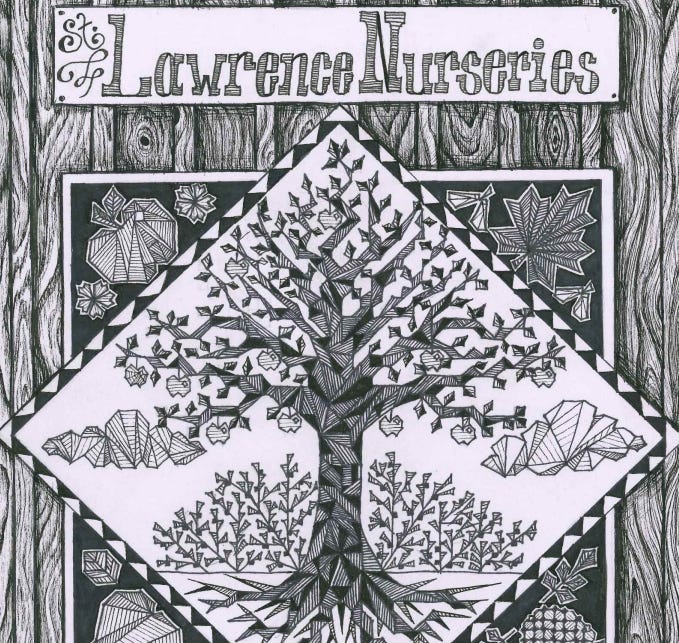Connecting Tradition, Craft, and Fun
Adventures in Cider
The falling leaves inspired this week’s Next Adventure. Toward the end of this newsletter, there are three recipes. The first is my hard cider recipe, followed by two recipes contributed by Lou Tamposi: Maple-Cured Turkey Leg with Apple Cider Braise and Stonewall Water.
Please check out Lou’s newsletter, Cow We Doin', for excellent recipes and writing.
From Root Cellars to Modern Crafting
Cider is fun. Cider is meaningful. Cider is historic. Cider is ancient. Cider is democratic.
Cider is an adventure.
The brown ceramic jugs in my grandparent’s root cellar were empty. The smell of mold and dank earth replaced the emptiness, a signal of life’s insistence to persist, a reality that modern homeowners try to remedy with perimeter drainage and dehumidifiers.
Once filled with apple cider and sealed, their fermentation is oblivious to the biome around them, an unyielding force through time and geography.
Tamed or untamed cider is ready to be discovered and forgotten in attics, roadsides, and forests, like a seed waiting for the perfect triggers for germination.
Ancient Elixir
6,500 BCE
Carbonized remains of apples found in the fertile crescent.1,300 BCE
The earliest known record of apple growing occurred along the Nile Delta.79 CE
Vesuvius erupts, killing Pliny the Elder. He kept records of 36 apple varieties.Sicera (Latin)—> Sidre (Old French)—> Cidre (Modern French)
A Journey Through Time and Taste
The movement of the apple from the Middle East to Europe and eventually to North America indicates a symbiotic expedition between apples, humans, and fungus, each shaping the other’s path.
I ask myself: “Who’s in control of who? Who’s calling the shots? The humans? The apples? The yeast?”
People eat apples, but people love cider. Cider is probably the reason why apples have been propagated all over the planet. Humans love to get “schnockered” (a word with etymological roots in the ancient words we use for cider).

Normandy, France, may be the birthplace of the hard cider we’re familiar with today, but England also has a historical claim dating back to Druid times.
Cider was an essential drink for settlers of the North American continent. Low-alcohol content cider was safer than water, so it was drunk widely, often at every meal. The perceived health benefits of cider vinegar continue to this day.
Apple Production & Consumption
The United States and Turkey produce nearly the same quantity of apples, each accounting for 6% of global production.
Washington State produces by far the most apples in the US.
Europe consumes the most cider (56%), while North America consumes nearly 10%.

The Life and Legacy of Cider: Crafting a Tradition That Endures
Cider is not wine. Wine is the fermented product of the grape, and cider the fermented product of the apple. Cider is cider.
Annie Proulx, Sweet & Hard Cider
My cider journey took a few twists and turns from that root cellar to now. First, I sought to grow apples and turn them into cider. Not enough apples.
Next, I went to a local orchard for their truckload apple sale: fill up a pickup truck with drop apples for $50/load. Processing these in a human-powered mill, I made this quantity only once.

Present-day, I go to a local orchard that allows me to buy sweet cider in bulk. I bring a carboy or two right up to their storage tanks and fill them, then place the ten gallons of cider back in the bed of my pickup.
Despite this streamlined approach (which feels a little bit like cheating compared to growing and pressing the apples myself), what I’ve always liked about cider is its accessibility. I can pick apples from a roadside tree with unknown provenance, grind them, squeeze them, and bottle the cider in a gallon glass jug I found in the “free shed” of my local dump. After adding $3 worth of white sugar, I can rely on the ever-present yeast found naturally on the untreated apple’s skin to do the remainder of the job. For next to nothing, I’ve made hard cider.
Or I could get fancy, using only certain pre-selected apple varieties for my cider, special yeasts, additions like oak chips for flavor, and particular sweeteners for unique flavors. I’ve tried some of these, and the differences in flavor are noticeable but not worth the hassle for me.
In both approaches, the simple and the overcomplicated, the cider prevails.
The Recipes
Jesse’s Hard Cider Recipe
There’s no shortage of recipes or advice out there for hard cider. After eleven years of making it, I’ve settled on this five-gallon hard cider recipe.
Ingredients:
5 gallons fresh, unpasteurized sweet cider.
5 pounds white sugar.
One packet of champagne yeast.
Specialized Equipment:
One five or six-gallon glass carboy.
Carboy cap for secure transport.
One fermentation lock.
One funnel that will fit the carboy for pouring.
Directions:
Collect your cider and keep it sealed to prevent spillage and ensure no contamination from bugs (especially fruit flies).
Take one or two gallons of cider and heat on the stovetop. Pour the sugar into the pot to dissolve. Do not boil.
Add the sugary cider back into the carboy.
Prepare the yeast per the instructions on the packet (this involves placing the yeast in warm water to activate it). Pour into the carboy.
Place the fermentation lock onto the carboy and watch the magic begin.
After a couple of weeks, it’s beneficial to rack off the cider and put it in another clean carboy or bucket to get the clean cider away from the dead yeast settled on the bottom.
After six to nine months, you’ll have proper cider to bottle. The sugar content of the apples and the amount of sugar you add will dictate the alcohol content. I used to measure the alcohol content with a hydrometer but decided I was no longer concerned with knowing the specific figure. On average, five gallons of sweet cider from my local orchard, combined with five pounds of white sugar, yields a hard cider with an alcohol content between 7 and 12%.
Applejack Once you have a hard cider, you can make applejack in the winter by freezing the liquid outside on the coldest winter night and pouring off the unfrozen liquid. The result is a homemade apple brandy.Maple-Cured Turkey Leg with Apple Cider Braise
Even for those not inclined to drink or use hard cider, cider is an undeniable ingredient of the fall season. In light of this, I’m pleased that Lou Tamposi, author of Cow We Doin', has agreed to provide a recipe that takes advantage of this unique, timeless, and historic ingredient.
From Lou:
When Jesse reached out asking if I’d be interested in contributing a cider-based recipe for this piece, I was thrilled. While I wouldn’t say I know everything there is to know about apple cider, I do love it. In New England, it is such a quintessentially fall ingredient — seeing cider donuts and gallons of cider appearing at farm stands and at farmers markets is a sure sign that colder weather is on the way. For me, that coincides with hunting season, with time spent in the woods — and, with the ensuing meals.
The recipe below is adapted from renowned wild game chef Jesse Griffiths’ The Turkey Book. And while the recipe is inspired by the spring turkey season, the flavor palette screams fall. Maple syrup and a warming spice mix of cinnamon, nutmeg, allspice, and pepper make the basis of a cure for a turkey leg, which is then cooked with carrot, onion, and apple, and then braised in apple cider until tender. Served over mashed potatoes, this is a recipe that might just as well make its way onto your Thanksgiving table. Harvesting your own bird, optional.
Maple-Cured Turkey Leg with Apple Cider Braise
½ cup kosher salt
1 tsp cinnamon
1 tsp nutmeg
½ tsp black pepper, ground
1 turkey leg quarter
½ cup maple syrup
All-purpose flour, as needed
2 tbsp duck fat (substitute lard or other oil)
1 large carrot, diced
1 large onion, diced
1 large apple, diced
2 tbsp butter
2 cups apple cider, plus more as needed
2 bay leaves
6 sprigs of fresh thyme
The day before you’re ready to cook, mix together the salt, cinnamon, nutmeg, and pepper and, in a shallow pan, rub vigorously all over the turkey leg. Pour maple syrup over the leg and continue to rub, scooping up the mix off the bottom of the pan to make sure the leg is covered. Cover, and let cure in the refrigerator for at least 24 hours.
The day of, remove the leg from the pan and rinse quickly to wash off some (but not all) of the cure. Pat dry and lightly dust with flour. Heat a large cast-iron Dutch oven or enameled pan over medium-high and add the duck fat. When the fat is shimmering, add the turkey leg, allowing to brown, but not burn, on all sides. Remove the leg when browned, and add the carrot, onion, and apple until they are lightly browned as well, and then add the butter, mixing to coat well, and cook for another minute or two.
Deglaze the pan with apple cider, scraping up the browned bits. Add back in the turkey leg with the bay leaves and thyme, and then add additional cider to just cover the leg. You could also, if you have it, add a splash of apple cider vinegar as well. Reduce heat to low and simmer until the leg is fall-apart-tender, about 4 hours.
When the meat is done, remove the leg, any bones, and the bay and thyme from the pot. Shred the meat and discard the bones and aromatics. Using an immersion blender, blend the veg and apples in the braising liquid into a fine puree – or, if you don’t have an immersion blender, pour into a regular blender and blend. Don’t skip this step. Pour the puree back into the pot and add the shredded turkey leg. Mix together and serve over mashed potatoes.
Lou’s Stonewall Water
New England is known for the stonewalls, built from the field stones, uncovered while the hardscrabble farmers were working to clear their fields, and used to mark property lines. When the leaves start to turn, these walls are often starkly apparent when driving back roads through the New England countryside. I like to make this twist on the Texas-staple, ranch water, to pay homage to the hard work that was required to give us this remarkable sense of place.
1 strong pour of whisky, rye, or bourbon (try Whistle Pig)
1 glug of apple cider vinegar (try American Vinegar Works)
Ice
Soda water or seltzer, chilled, to top
Mix the liquor and apple cider vinegar in a rocks glass or tumbler, and then add ice. Stir, and then top with soda water or seltzer to taste.
Recommended Resources
Sweet & Hard Cider: Making it, Using it, and Enjoying it
An excellent reference for all things cider (e.g., history, how-to, etc.) is Annie Proulx and Lew Nichol’s book, “Sweet & Hard Cider: Making it, Using it, and Enjoying it,” from Garden Way Books in 1980. I consider it the bible of cider-making, and its thorough and comprehensive history is second to none. This is the original book cover:
I’ve ordered trees from them and recommend giving them a try. Their PDF catalog is fun to look at and includes an extensive listing of apple varieties based on your needs, such as cider, baking, or wildlife.








love this, cider is very underrated! Also nice from an environmental perspective because it's a cold ferment, no heat is needed (I don't think?)
I'm curious, where does Johnny Appleseed fit into the historical account of apples? All jokes aside, this was a great read. Thanks for sharing!